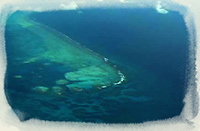FRIENDS OF NATURE BELIZE | GLADDEN SPIT & SILK CAYES
| HOME |
| PROTECTED AREAS |
| RESEARCH |
| EDUCATION/OUTREACH |
| OUR HISTORY |
| JOIN US (coming soon) |

GLADDEN SPIT

SPAWNING AGGREGATION

WHALE SHARK WATCH
| FoN BELIZE: ON THE BARRIER REEF |
|
LAUGHING BIRD CAYE PLACENCIA LAGOON Since the 1920s, fishermen have congregated at Gladden Spit on the Belize Barrier Reef to harvest mutton snapper and grouper during the ten-day period around full moon during the months of March through June. The fishermen often landed huge catches, and many of the fish were carrying eggs (gravid). Often the men noticed huge whale sharks swimming nearby, usually surrounded by a milkiness in the water. In 1997, a team of scientists and local fishermen found that the snappers came together to spawn, filling the water with milky eggs and sperm, and that the whale sharks -- filter feeders -- had come to eat the eggs -- a combination of events that is both biologically important and thrilling. .... Some local tour operators from Placencia, the closest village to Gladden Spit, soon discovered the tourism potential of the predictable presence of whale sharks, and a new industry quickly grew up. In 2001, the site of the whale sharks was declared a protected area, Gladden Spit and Silk Cayes Marine Reserve (GSSCMR). In 2002 FoN signed a Memo Of Understanding with the Government of Belize to co-manage the Reserve, and a strict set of guidelines has been set in place to ensure a safe and ecologically-sound experience for everyone. This area is now very diligently protected and enforced by our Park Rangers, both from illegal fishing and to protect the wonderful world of the whale sharks. .... FoN has studied the spawning fish in the reserve every month for years. A team of divers is regularly sent to the site twice a day for at least 10 days after each full moon. It has been found that over 20 different species of reef fish congregate here, each with its own particular month - a unique biological clock. .... FoN is particularly focused on the mutton snappers, the most common commercial fin fish harvested in Belize. The snappers appear from March to June, the same months as the cubera snappers and dog snappers. The latter two species produce particularly large, tasty eggs, seemingly one of the primary motives for the presence of the great whale sharks.
|

BELIZE
CENTRAL AMERICA
